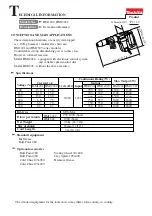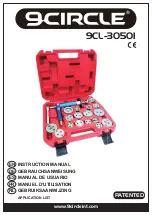
Multi-Purpose Oscillating Tool
7
For technical questions call: 1-800-665-8685
8336232
V 1.5
MAINTENANCE
1. The brushes should be checked periodically and worn-out brushes should be replaced. After replacing,
inspect whether the new brushes can move freely in the brush holder. Run the motor for 15 minutes without
load to shape the brushes, so that they are properly aligned with the commutator.
2. Keep the vent passage clear from dirt. Clean off the accumulated dust and oil dirt periodically.
3. During normal operation, if anything happens, the power supply should be cut off at once and the tool
should be checked and repaired.
4. Clean the tool after each use.
CAUTION: Only qualified service personnel should repair the tool.
REPLACING CARBON BRUSHES
1. Using the parts list included, locate the carbon brushes. Remove the brush holder caps with a screwdriver
and inspect the carbon brushes. Replace them when they are worn up to about one third.
2. Take the old brush out and install new brushes. Remove all of the brushes at once. Make sure the brush
slides freely within the brush housing.
3. Run the motor for 15 minutes without load to shape the brushes, so that they are properly aligned with
the commutator.
4. Replace the brush caps. Do not over tighten them.
SPECIFIC SAFETY RULES FOR MULTI-PURPOSE OSCILLATING TOOLS
WARNING! DO NOT LET COMFORT OR FAMILIARITY WITH PRODUCT (GAINED FROM REPEATED USE) REPLACE
STRICT ADHERENCE TO PRODUCT SAFETY RULES. If you use this tool unsafely or incorrectly, you
can suffer serious personal injury!
WARNING! Hold tool by insulated gripping surfaces when performing an operation where cutting tools may
contact hidden wiring or its own cord. Contact with a “live” wire will make exposed metal parts of
the tool “live” and shock the operator!
• Always wear safety glasses or goggles. Normal prescription eye or sunglasses are not safety glasses.
• Hold the Oscillating Tool by its insulated gripping surfaces to avoid electrical shock from unseen “live” wires.
• Always hold the tool firmly. DO NOT leave the tool running unless hand held.
• Check your work area for proper clearances before cutting. This will avoid cutting into your workbench,
the floor, etc.
• DO NOT cut nails or screws unless you are using a blade specifically designed for this purpose. Inspect your
material before cutting.
• Before switching on the tool, be sure the blade is not contacting the work piece.
• Do not use the tool if switch does not turn on or off. Any tool which can not be controlled by the switch is
dangerous and must be repaired.
• Wear cushioned protective gloves to minimize the vibration. Excessive vibration may cause personal injury.
• Do not wet-sand with this tool. Water or moisture entering the motor housing can cause electric shock and
serious personal injury.
• Always be sure that the tool is switched off and unplugged before adjusting, adding accessories, or checking
a function on the tool.








































